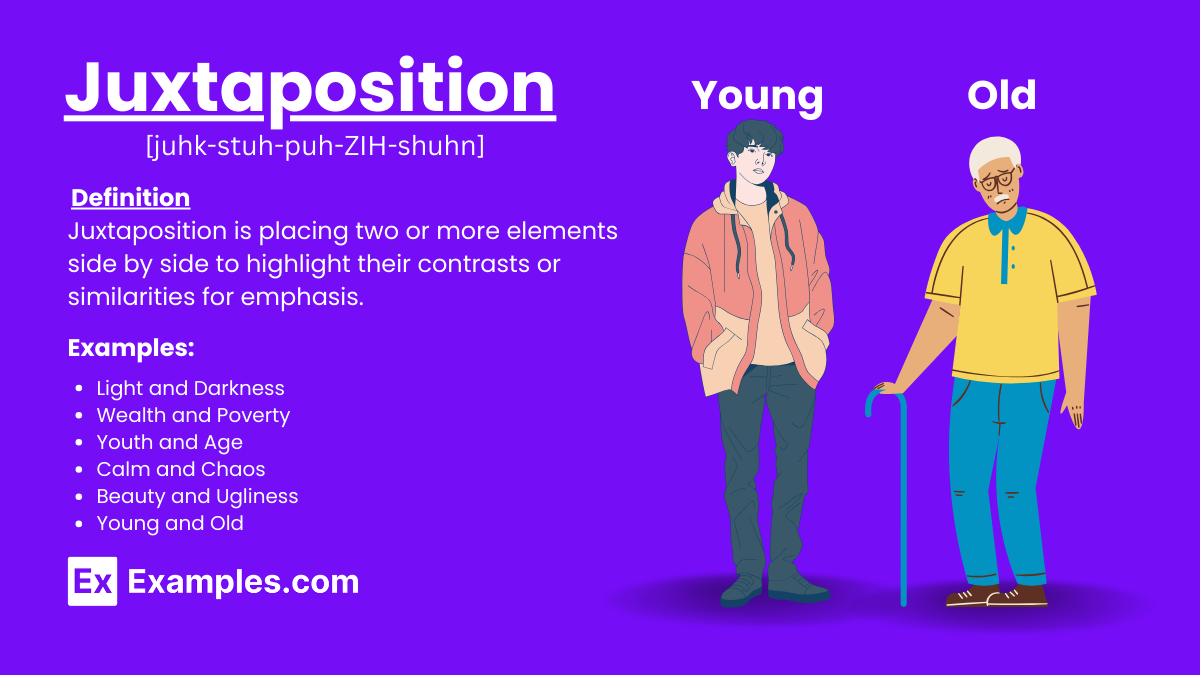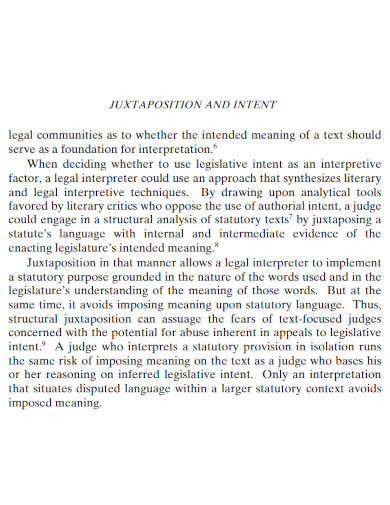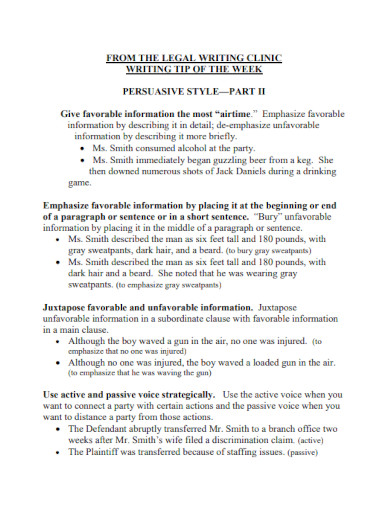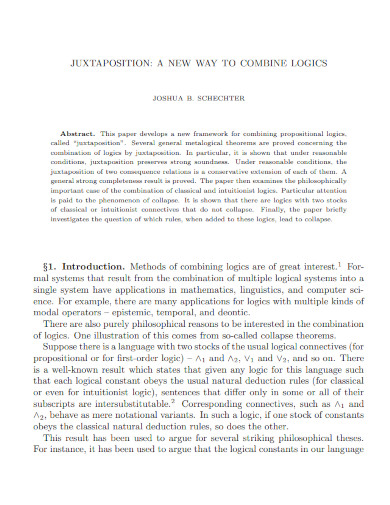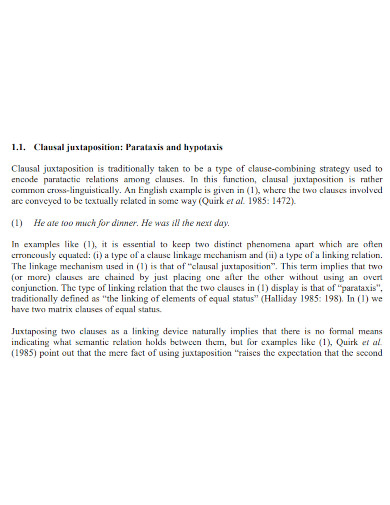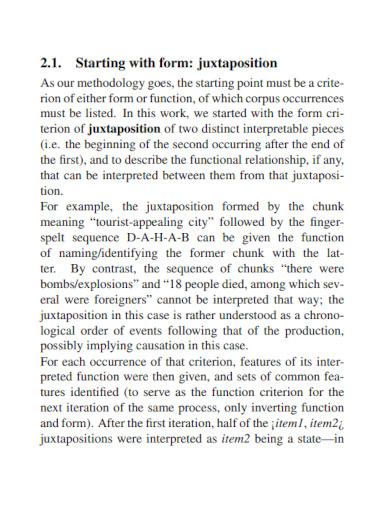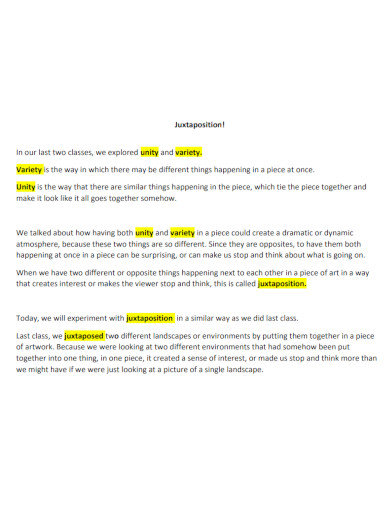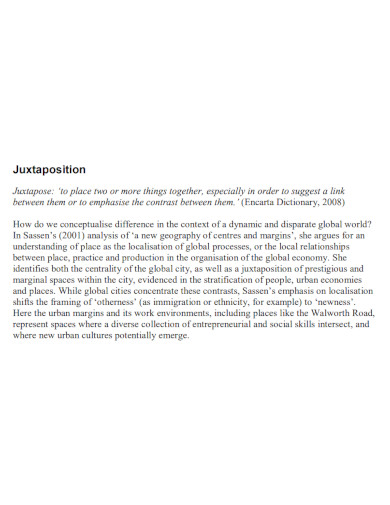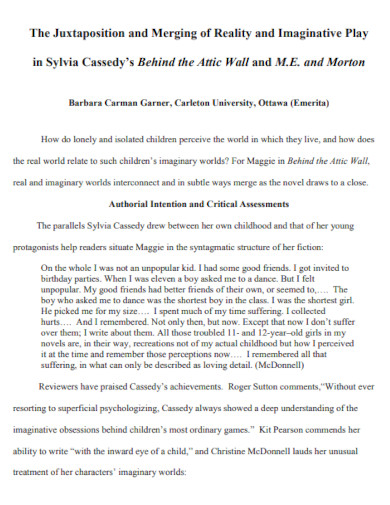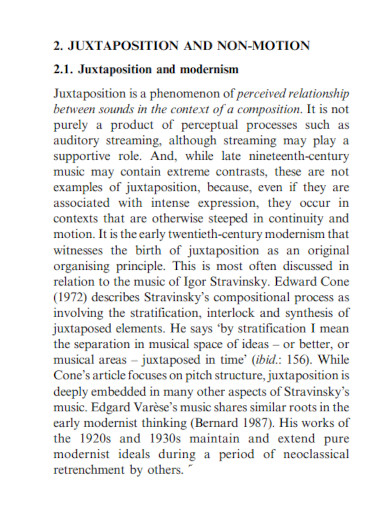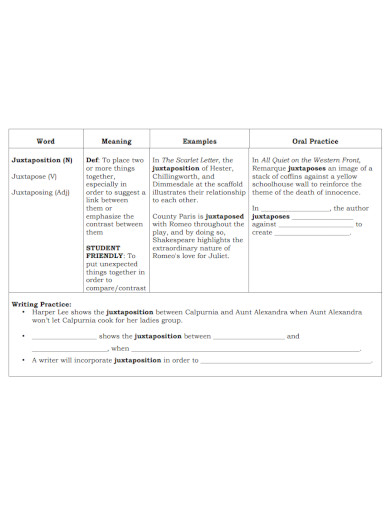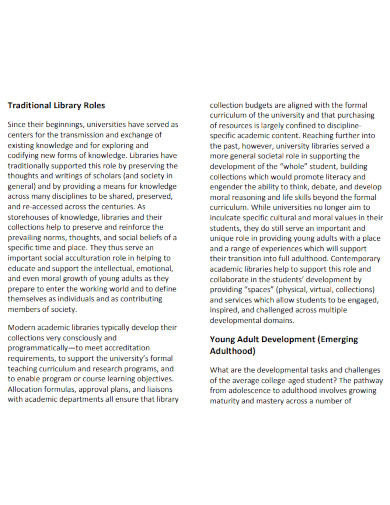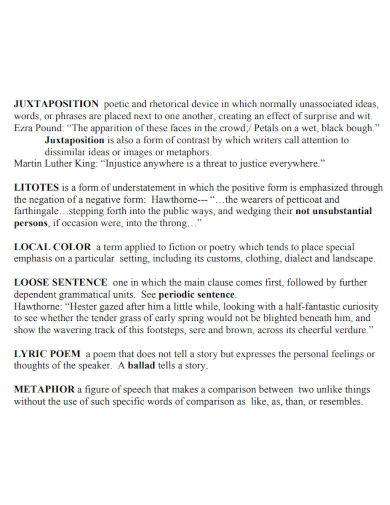Juxtaposition
Juxtaposition places two contrasting elements side by side to highlight their differences, creating a powerful effect. In literature, it enhances theme, deepens character complexity, and underscores dramatic moments. This technique invites readers to compare and contrast, leading to richer interpretations. Whether in novels, poetry, or essays, juxtaposition sharpens distinctions, adding depth and intrigue to the narrative.
When someone calls another notoriously kind, what do they mean? The statement or phrase notoriously kind is a mix of two contradictory words paired with one another to create a whole new meaning. This phrase is an example of a juxtaposition, in a literary sense.
What is Juxtaposition?
Juxtaposition is a literary technique that places two or more elements side by side to highlight their contrasts or similarities. This method creates vivid imagery, emphasizes differences, or reveals hidden connections, enhancing the reader’s understanding and adding depth to the narrative. Juxtaposition is widely used in literature, art, and everyday language to provoke thought and elicit emotional responses.
When is Juxtaposition used?
Juxtaposition is used in various contexts to enhance meaning and impact:
- Literature: To contrast characters, settings, or themes.
- Art: To place contrasting elements side by side for visual impact.
- Film and Photography: To create striking imagery and highlight differences.
- Everyday Language: To emphasize differences or similarities in conversations or writing.
- Advertising: To compare products and highlight advantages.
Juxtaposition Examples:
Juxtaposition Examples in Literature
Juxtaposition is a literary technique where two or more ideas, places, characters, and their actions are placed side by side in a narrative or a poem to develop comparisons and contrasts. Here are some examples from literature:
- “A Tale of Two Cities” by Charles Dickens:
- Opening lines: “It was the best of times, it was the worst of times, it was the age of wisdom, it was the age of foolishness…”
- This famous opening contrasts extremes to highlight the contradictions and dualities of the era.
- “Romeo and Juliet” by William Shakespeare:
- Light and dark imagery: “It is the east, and Juliet is the sun. Arise, fair sun, and kill the envious moon…”
- Shakespeare contrasts light and darkness to enhance the theme of love and conflict.
- “1984” by George Orwell:
- The Party’s slogans: “War is peace. Freedom is slavery. Ignorance is strength.”
- These contradictory statements highlight the manipulation and control within the dystopian society.
- “Pride and Prejudice” by Jane Austen:
- Character juxtaposition: Elizabeth Bennet and Mr. Darcy.
- Their differing personalities and backgrounds emphasize themes of class, marriage, and personal growth.
- “To Kill a Mockingbird” by Harper Lee:
- Good and evil: The characters of Atticus Finch and Bob Ewell.
- Their contrasting moral compasses highlight the themes of justice and racism.
- “Great Expectations” by Charles Dickens:
- Wealth and poverty: The lives of Pip and Joe Gargery.
- This contrast emphasizes themes of social class and ambition.
- “Brave New World” by Aldous Huxley:
- Savage Reservation vs. World State: The contrasting societies.
- This juxtaposition explores themes of civilization, control, and freedom.
- “The Great Gatsby” by F. Scott Fitzgerald:
- East Egg vs. West Egg: Different social classes.
- This contrast underscores themes of wealth, class, and the American Dream.
- “Heart of Darkness” by Joseph Conrad:
- Light and darkness imagery.
- The juxtaposition is used to explore the themes of civilization versus savagery.
- “Frankenstein” by Mary Shelley:
- Victor Frankenstein and his creation.
- Their contrasting natures and fates highlight themes of creation, ambition, and responsibility.
Juxtaposition Examples in Art
Juxtaposition in art involves placing two or more elements together to highlight their differences and create a contrasting effect. Here are some notable examples:
- Salvador Dalí – “The Persistence of Memory” (1931):
- Surreal juxtaposition of melting clocks in a natural landscape.
- The contrast between the fluid, distorted clocks and the solid, realistic background creates a dreamlike, unsettling effect.
- René Magritte – “The Son of Man” (1964):
- A man in a suit with an apple obscuring his face.
- The ordinary, realistic image of a man is juxtaposed with the bizarre placement of the apple, challenging viewers’ perceptions of reality.
- Pablo Picasso – “Guernica” (1937):
- Juxtaposes elements of chaos and destruction with symbols of peace.
- The black-and-white palette and fragmented forms highlight the horrors of war.
- Michelangelo – The Sistine Chapel Ceiling (1508-1512):
- Juxtaposition of divine and human figures.
- The creation scenes juxtapose the divine presence of God with the human figures, emphasizing the connection between the divine and mortal worlds.
- Banksy – “Balloon Girl” (2002):
- A young girl reaching for a red balloon, contrasted against a gray, urban background.
- The colorful balloon symbolizes hope and innocence against the stark, dreary environment.
- Yayoi Kusama – “Infinity Mirror Rooms” (1965-present):
- Juxtaposes infinite reflections with singular objects.
- The use of mirrors creates a surreal, infinite space, contrasting with the physical limitations of the gallery.
- Frida Kahlo – “The Two Fridas” (1939):
- Juxtaposition of two versions of herself: one in traditional Mexican attire and the other in a European dress.
- This contrast explores themes of identity, cultural duality, and personal struggle.
- Henri Rousseau – “The Dream” (1910):
- Juxtaposes a reclining woman in a lush, exotic jungle.
- The realistic depiction of the woman contrasts with the fantastical, dreamlike setting.
- David Hockney – “A Bigger Splash” (1967):
- Contrasts the splash of water with the stillness of the surrounding environment.
- The dynamic movement of the water is juxtaposed with the calm, static scene, creating a striking visual effect.
- Grant Wood – “American Gothic” (1930):
- Juxtaposes the stern, traditional figures of a farmer and his daughter with the Gothic-style house in the background.
- The contrast between the figures’ expressions and the architectural style highlights themes of rural American life and cultural heritage.
Juxtaposition Examples in Movies
Juxtaposition in movies is used to create contrast between characters, scenes, themes, or visual elements to enhance the storytelling. Here are some notable examples:
- “The Godfather” (1972):
- Juxtaposition of the baptism scene with the assassination of the Corleone family’s enemies.
- The sacred ceremony contrasts sharply with the violent killings, highlighting the duality of Michael Corleone’s life.
- “Schindler’s List” (1993):
- The girl in the red coat amidst the black-and-white film.
- This striking use of color amidst the monochrome emphasizes the innocence lost during the Holocaust.
- “Forrest Gump” (1994):
- Juxtaposition of Forrest’s simple, kind-hearted nature with the complex, often harsh realities of the world around him.
- The contrast highlights themes of innocence, destiny, and the impact of historical events on individual lives.
- “Black Swan” (2010):
- The juxtaposition of Nina’s white swan persona with her black swan persona.
- The duality emphasizes her internal struggle and descent into madness.
- “Pulp Fiction” (1994):
- Juxtaposition of different storylines and timelines.
- The non-linear narrative contrasts different characters and events, creating a rich, interconnected tapestry of stories.
- “Up” (2009):
- Juxtaposition of the joyful opening sequence of Carl and Ellie’s life together with the subsequent sadness of Ellie’s death.
- This contrast sets up the emotional journey of the main character.
- “American Beauty” (1999):
- Juxtaposition of suburban life’s facade with the underlying dysfunction.
- The contrast reveals the characters’ hidden desires and struggles, critiquing the notion of the American Dream.
- “The Dark Knight” (2008):
- The juxtaposition of Batman and the Joker.
- Their contrasting moral philosophies and methods highlight themes of chaos versus order and justice versus anarchy.
- “Inception” (2010):
- Juxtaposition of different dream layers and realities.
- The complex layering of dreams contrasts with the real world, exploring themes of perception and reality.
- “Parasite” (2019):
- Juxtaposition of the poor Kim family’s semi-basement home with the wealthy Park family’s luxurious house.
- The stark contrast between the living conditions emphasizes themes of class disparity and social inequality.
Juxtaposition Examples in Poetry
Juxtaposition in poetry involves placing two or more contrasting elements close together to highlight their differences or to create a specific effect. Here are some examples of juxtaposition in poetry:
- “The Tyger” by William Blake:
- “Tyger Tyger, burning bright, / In the forests of the night;”
- Juxtaposes the fierce, powerful tiger with the dark, mysterious forest, exploring themes of creation and destruction.
- “Do Not Go Gentle into That Good Night” by Dylan Thomas:
- “Rage, rage against the dying of the light.”
- Juxtaposes the passive acceptance of death with a fierce resistance, emphasizing the struggle against mortality.
- “The Waste Land” by T.S. Eliot:
- “April is the cruellest month, breeding / Lilacs out of the dead land,”
- Juxtaposes the renewal of spring with the barrenness of the wasteland, highlighting themes of regeneration and despair.
- “Ode to a Nightingale” by John Keats:
- “Thou wast not born for death, immortal Bird! / No hungry generations tread thee down;”
- Juxtaposes the eternal song of the nightingale with the transient nature of human life, exploring themes of immortality and fleeting existence.
- “A Dream Within a Dream” by Edgar Allan Poe:
- “All that we see or seem / Is but a dream within a dream.”
- Juxtaposes reality with illusion, questioning the nature of existence and perception.
- “The Road Not Taken” by Robert Frost:
- “Two roads diverged in a wood, and I— / I took the one less traveled by,”
- Juxtaposes the two paths in the woods, symbolizing different life choices and their consequences.
- “Sonnet 18” by William Shakespeare:
- “Shall I compare thee to a summer’s day? / Thou art more lovely and more temperate:”
- Juxtaposes the beauty of a summer day with the enduring beauty of the beloved, highlighting the theme of eternal love.
- “I Wandered Lonely as a Cloud” by William Wordsworth:
- “I wandered lonely as a cloud / That floats on high o’er vales and hills,”
- Juxtaposes the poet’s loneliness with the joyful beauty of the daffodils, emphasizing the transformative power of nature.
- “Fire and Ice” by Robert Frost:
- “Some say the world will end in fire, / Some say in ice.”
- Juxtaposes fire and ice to explore themes of passion and destruction, as well as the potential causes of the world’s end.
- “Because I Could Not Stop for Death” by Emily Dickinson:
- “Because I could not stop for Death – / He kindly stopped for me –”
- Juxtaposes the inevitability of death with the gentleness of its approach, exploring themes of mortality and the afterlife.
Juxtaposition Examples in Songs
Juxtaposition in songs can be used to create powerful contrasts between themes, emotions, or imagery. Here are some notable examples:
- “Imagine” by John Lennon:
- “Imagine there’s no heaven / It’s easy if you try / No hell below us / Above us only sky”
- Juxtaposes the concept of an ideal, peaceful world with the harsh realities of the existing world.
- “Hey Ya!” by OutKast:
- Upbeat, energetic music contrasts with lyrics about a failing relationship.
- The juxtaposition creates a complex emotional experience, highlighting the tension between appearance and reality.
- “Ironic” by Alanis Morissette:
- “It’s like rain on your wedding day / It’s a free ride when you’ve already paid”
- Juxtaposes ironic situations to explore the unpredictability and contradictions of life.
- “Hallelujah” by Leonard Cohen:
- “Love is not a victory march / It’s a cold and it’s a broken Hallelujah”
- Juxtaposes the sacred and the profane, highlighting the complexity and pain of love.
- “Bittersweet Symphony” by The Verve:
- “Try to make ends meet, you’re a slave to money then you die”
- Juxtaposes the beautiful, orchestral melody with lyrics about life’s struggles and materialism.
- “Boulevard of Broken Dreams” by Green Day:
- “I walk a lonely road / The only one that I have ever known”
- Juxtaposes the idea of a “boulevard” (a typically lively, populated place) with the loneliness and isolation described in the lyrics.
- “Every Breath You Take” by The Police:
- “Every breath you take / Every move you make / I’ll be watching you”
- The soothing, melodic tune contrasts with the obsessive, stalker-like lyrics, creating a dissonance that underscores the unsettling nature of the song.
- “Tears Dry on Their Own” by Amy Winehouse:
- Upbeat, Motown-inspired melody contrasts with lyrics about heartbreak and moving on.
- This juxtaposition highlights the resilience and complexity of dealing with emotional pain.
- “Happy” by Pharrell Williams:
- “Clap along if you feel like a room without a roof”
- The carefree, joyful music is juxtaposed with the metaphor of being uncontained and limitless, emphasizing a sense of unbounded happiness.
- “Royals” by Lorde:
- “And we’ll never be royals / It don’t run in our blood”
- Juxtaposes the opulent imagery of luxury and royalty with the reality of a simpler, more grounded life, critiquing materialism and celebrity culture.
Juxtaposition Examples in Disney Movies
Juxtaposition in Disney movies often enhances storytelling by contrasting characters, settings, themes, and emotions. Here are some notable examples:
- “Beauty and the Beast” (1991):
- The contrast between Belle and the Beast.
- Belle’s beauty and kindness are juxtaposed with the Beast’s outwardly monstrous appearance, highlighting themes of inner beauty and transformation.
- “The Lion King” (1994):
- The juxtaposition of the Pride Lands under Mufasa’s rule and Scar’s rule.
- The vibrant, thriving kingdom under Mufasa contrasts with the barren, desolate state of the Pride Lands under Scar, emphasizing the consequences of good versus evil leadership.
- “Frozen” (2013):
- Juxtaposition of Elsa’s ice powers and Anna’s warm, outgoing personality.
- Elsa’s icy powers and isolation contrast with Anna’s warmth and sociability, highlighting themes of fear versus love and isolation versus connection.
- “Cinderella” (1950):
- The contrast between Cinderella’s life before and after the ball.
- Cinderella’s life of hardship and servitude is juxtaposed with the magical, glamorous experience at the ball, emphasizing themes of transformation and hope.
- “Aladdin” (1992):
- The contrast between Aladdin’s humble beginnings and the opulence of the Sultan’s palace.
- Aladdin’s life as a “diamond in the rough” contrasts with the wealth and luxury of the palace, highlighting themes of identity and true worth.
- “The Little Mermaid” (1989):
- Juxtaposition of Ariel’s underwater world and the human world.
- The vibrant, colorful ocean world contrasts with the human world above, emphasizing Ariel’s longing for a different life and the theme of belonging.
- “Mulan” (1998):
- The contrast between Mulan’s life as a traditional woman and her life as a warrior.
- Mulan’s constrained, traditional role at home contrasts with her empowered, courageous role in the army, highlighting themes of gender roles and self-discovery.
- “Tangled” (2010):
- Juxtaposition of Rapunzel’s tower and the outside world.
- The confined, isolated tower contrasts with the vast, adventurous outside world, emphasizing Rapunzel’s growth and quest for freedom.
- “Zootopia” (2016):
- The contrast between Judy Hopps, a small, optimistic rabbit, and the larger, more cynical predators she encounters.
- This juxtaposition highlights themes of prejudice, ambition, and the complexity of societal roles.
- “Moana” (2016):
- The juxtaposition of Moana’s island life and the vast, unknown ocean.
- Moana’s secure but limiting life on the island contrasts with the adventurous and dangerous ocean journey, emphasizing themes of exploration, courage, and identity.
More Juxtaposition Templates & Examples:
1. Juxtaposition and Intent
2. Juxtaposing in Persuasive Writing
3. Juxtaposition Sample
4. Clausal Juxtaposition
5. Juxtaposition PDF
6. Juxtaposition Example
7. Basic Juxtaposition
8. Printable Juxtaposition
9. Juxtaposition of Source Files
10. Juxtaposition and Non-Motion
11. Juxtaposition Activity
12. Juxtaposition Template Example
13. Juxtaposition Format
14. Juxtaposition Literary
Juxtaposition vs. Oxymoron
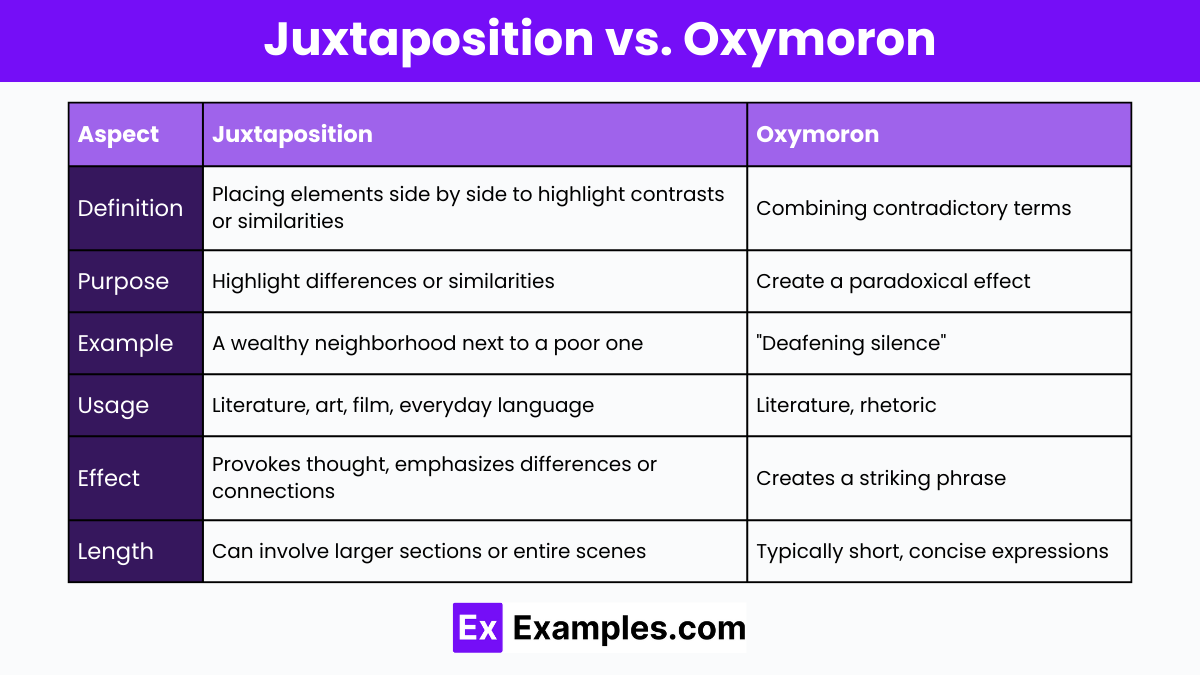
| Aspect | Juxtaposition | Oxymoron |
|---|---|---|
| Definition | Placing two or more elements side by side | Combining two contradictory terms |
| Purpose | Highlight contrasts or similarities | Create a paradoxical effect |
| Example | A wealthy neighborhood next to a poor one | “Deafening silence” |
| Usage | Widely used in literature, art, film, and everyday language | Common in literature and rhetoric |
| Effect on Audience | Provokes thought and emphasizes differences or connections | Creates a striking, memorable phrase |
| Complexity | Can involve more complex structures | Generally involves short, simple phrases |
| Visual or Conceptual | Can be both visual and conceptual | Primarily conceptual |
| Length | Can involve larger sections of text or entire scenes | Typically short, concise expressions |
Synonyms & Antonyms for Juxtapositions
| Synonyms | Antonyms |
|---|---|
| Contrast | Separation |
| Comparison | Isolation |
| Collocation | Division |
| Apposition | Disconnection |
| Proximity | Distance |
| Adjacency | Remoteness |
| Placement | Detachment |
| Arrangement | Segregation |
| Conjunction | Divergence |
| Alignment | Disjunction |
| Opposition | Apartness |
| Comparison | Disparity |
| Nearness | Dissociation |
| Parallels | Divergence |
| Analogies | Gap |
| Relationships | Isolation |
| Similes | Division |
| Contrasts | Separation |
| Coordination | Estrangement |
| Combination | Alienation |
How to create your own Juxtapositions
How to Use Juxtaposition
Juxtapositions are complex phrases and statements you can usually find in movies, television, books, or essays. This is also present in modern artworks and images created by artists around the world. You are free to peruse the examples and samples of juxtaposition found on the list above to help increase your understanding of this concept.
1.) Find Two or More Contrasting Words, Concepts, and Ideas
Start by looking for two specific words, concepts, and ideas that contrast with one another. You can easily do this by utilizing dictionary definitions, and thesauruses as your reference. Note that the format of the juxtaposition is either word/word or a contrasting adjective followed by the contrasting word.
2.) Define these Two or More Contrasting Words, Concepts, and Ideas
After finding these words, use a dictionary to find an applicable and appropriate definition for these words. If both of the chosen words are not contradicting or contrasting then repeat step 1 until you find a pair of contrasting words.
3.) Insert these Two Contrasting Words, Concepts, and Ideas in a Statement
When you have finished defining these words, find an applicable statement to insert your desired juxtaposition. But if the juxtaposition doesn’t fit repeat steps 1 and 2 until you find one.
4.) Repeat until Satisfied
After inserting the juxtaposition you can repeat steps 1 through 3 until you are satisfied with the result. Just note that too much usage of juxtaposition can lead to a frustrated audience.
What is juxtaposition in literature?
Juxtaposition in literature is a technique where two or more ideas, places, characters, or actions are placed side by side to highlight their contrasts or similarities.
Why do authors use juxtaposition?
Authors use juxtaposition to emphasize differences or similarities, create vivid imagery, and add depth to their narratives, enhancing the reader’s understanding and emotional engagement.
How does juxtaposition affect the reader?
Juxtaposition provokes thought, elicits emotional responses, and enhances the reader’s understanding by highlighting contrasts or connections between elements in the narrative.
Can juxtaposition be used in art?
Yes, artists use juxtaposition to place contrasting elements side by side, creating visual interest and emphasizing differences or similarities, often provoking thought or eliciting emotions.
What is an example of juxtaposition?
An example of juxtaposition is placing a wealthy neighborhood next to a poor one in a story to highlight socioeconomic contrasts and provoke thought.
Is juxtaposition the same as contrast?
While juxtaposition involves placing elements side by side to highlight differences or similarities, contrast specifically focuses on highlighting differences between two or more elements.
How does juxtaposition enhance a narrative?
Juxtaposition enhances a narrative by creating vivid imagery, emphasizing contrasts or similarities, and adding depth, which engages the reader and enhances their understanding of the story.
Can juxtaposition be used in everyday language?
Yes, juxtaposition is used in everyday language to emphasize differences or similarities in conversations or writing, making points more striking and memorable.
What is the difference between juxtaposition and oxymoron?
Juxtaposition places two elements side by side for comparison, while an oxymoron combines two contradictory terms to create a paradoxical effect.
How is juxtaposition used in film?
In film, juxtaposition is used to create striking imagery and highlight contrasts or similarities between scenes, characters, or actions, enhancing the storytelling and emotional impact.



